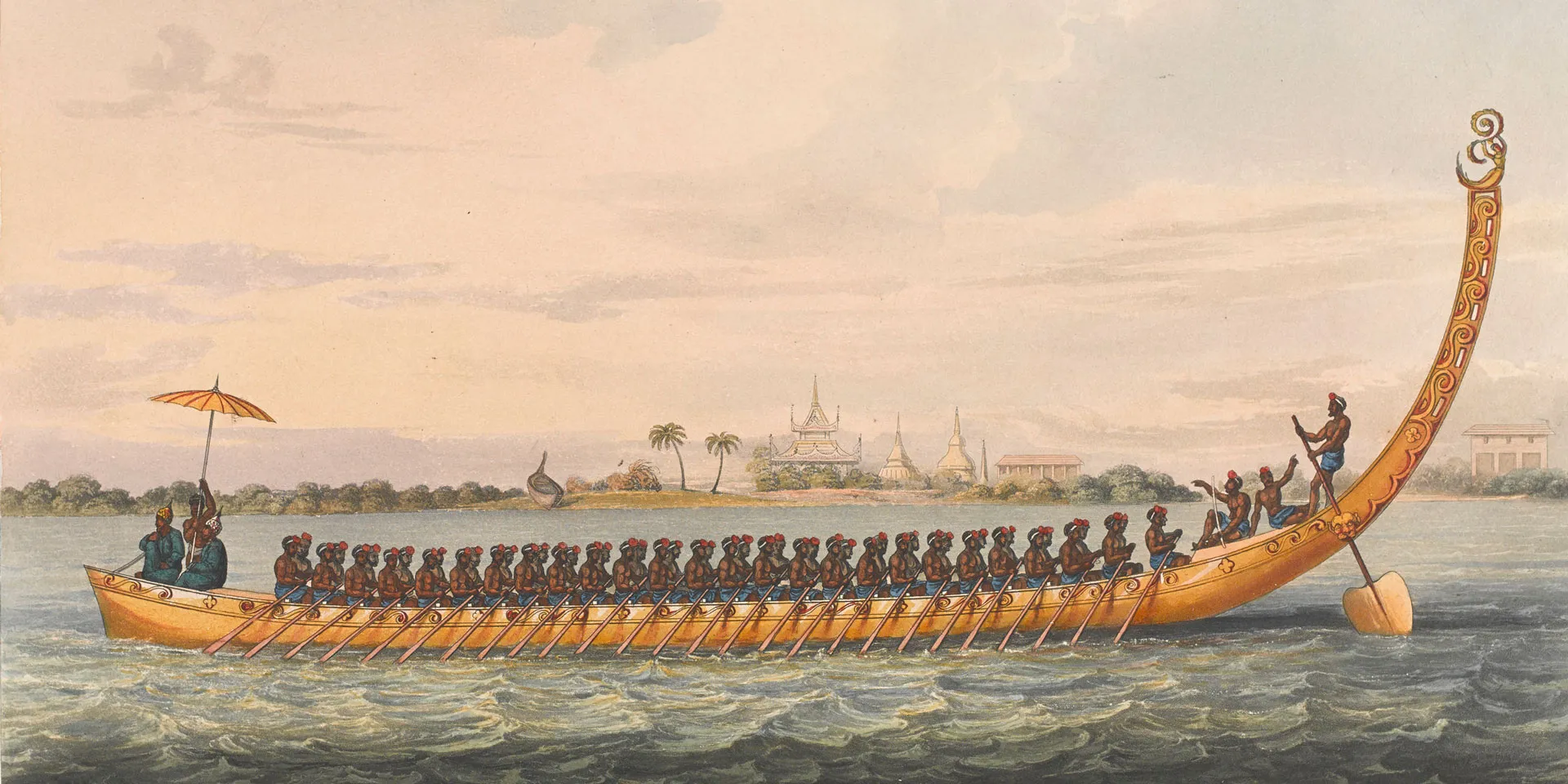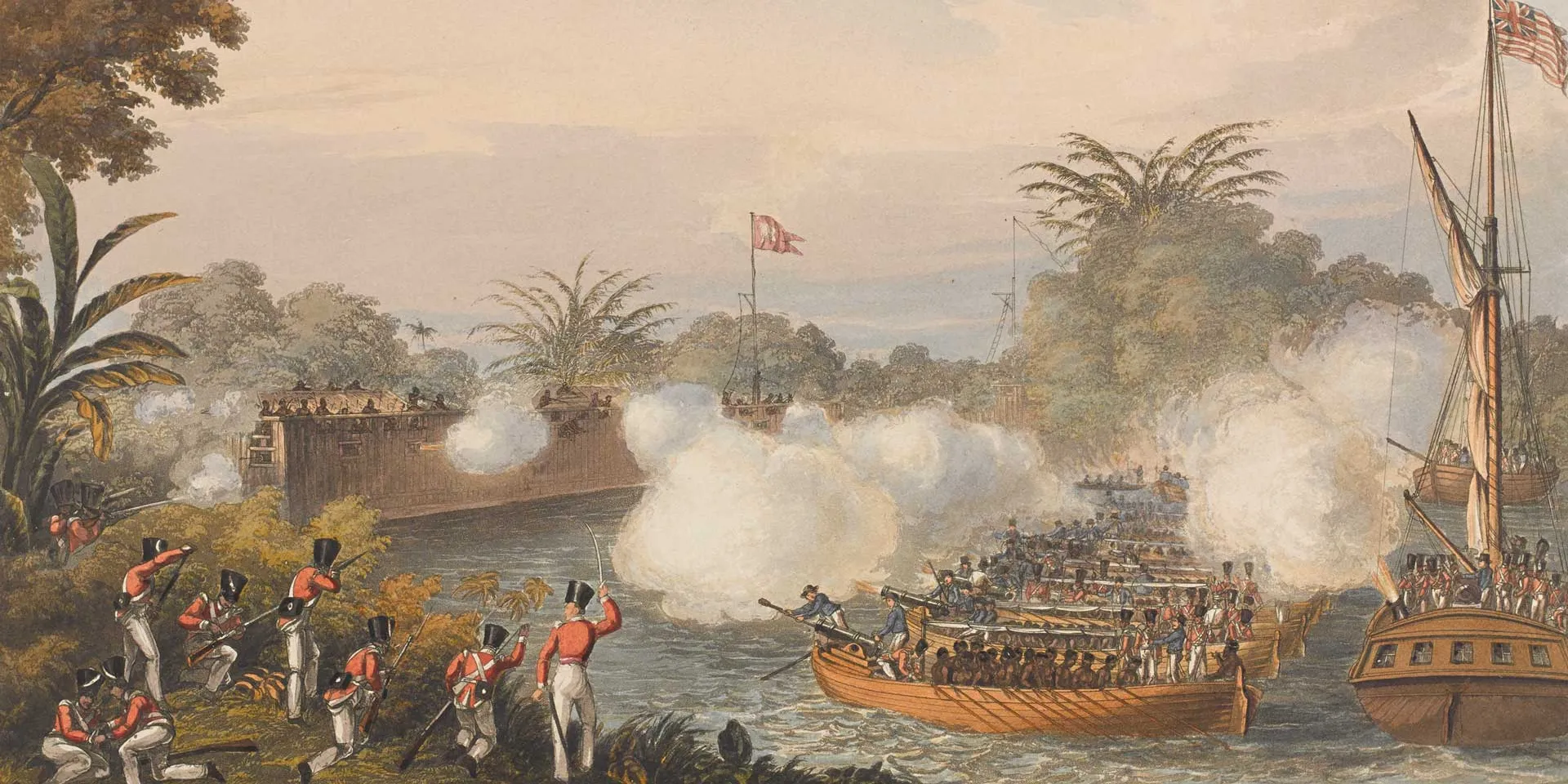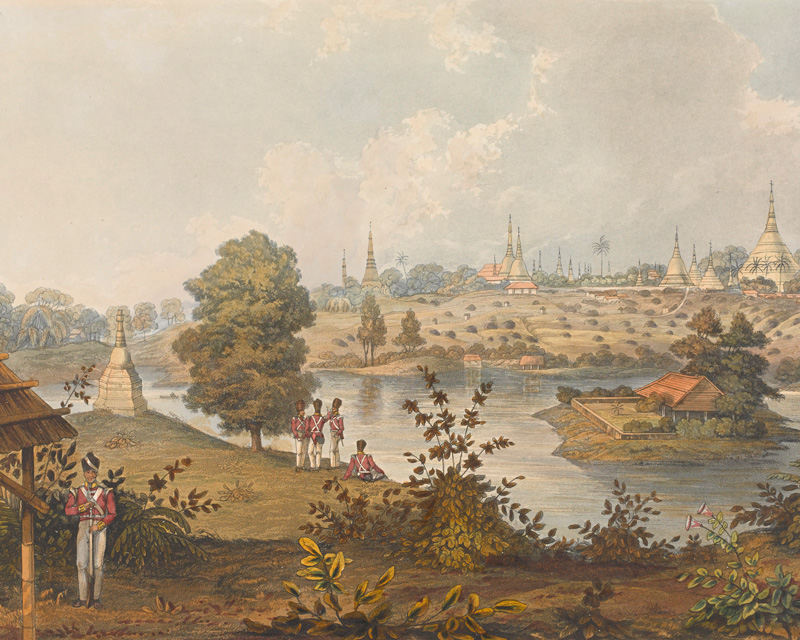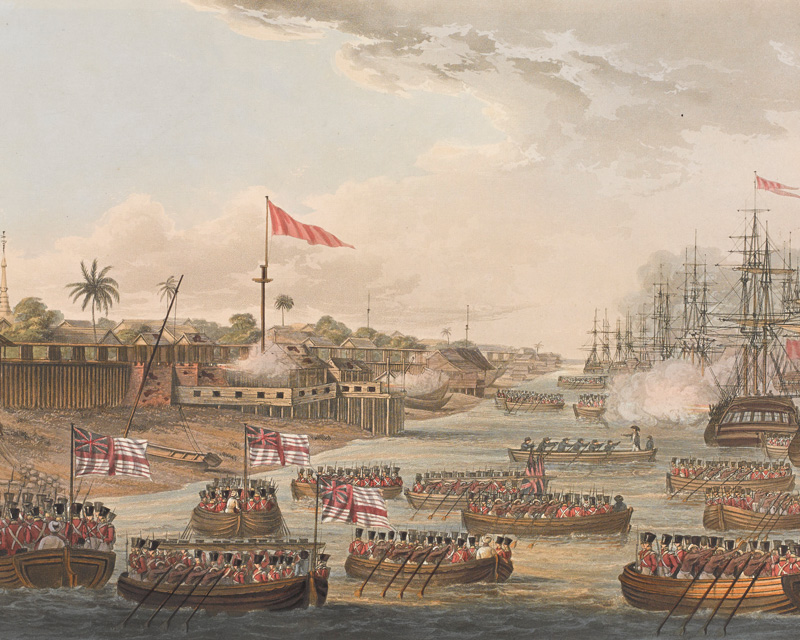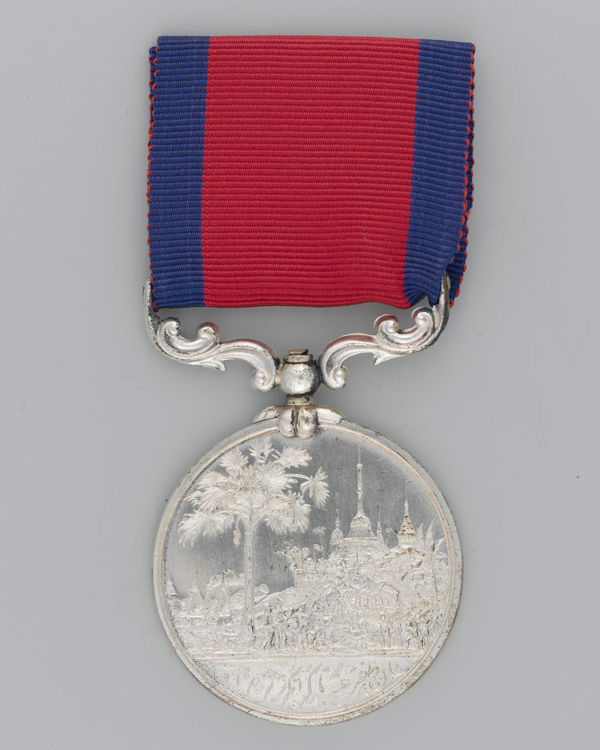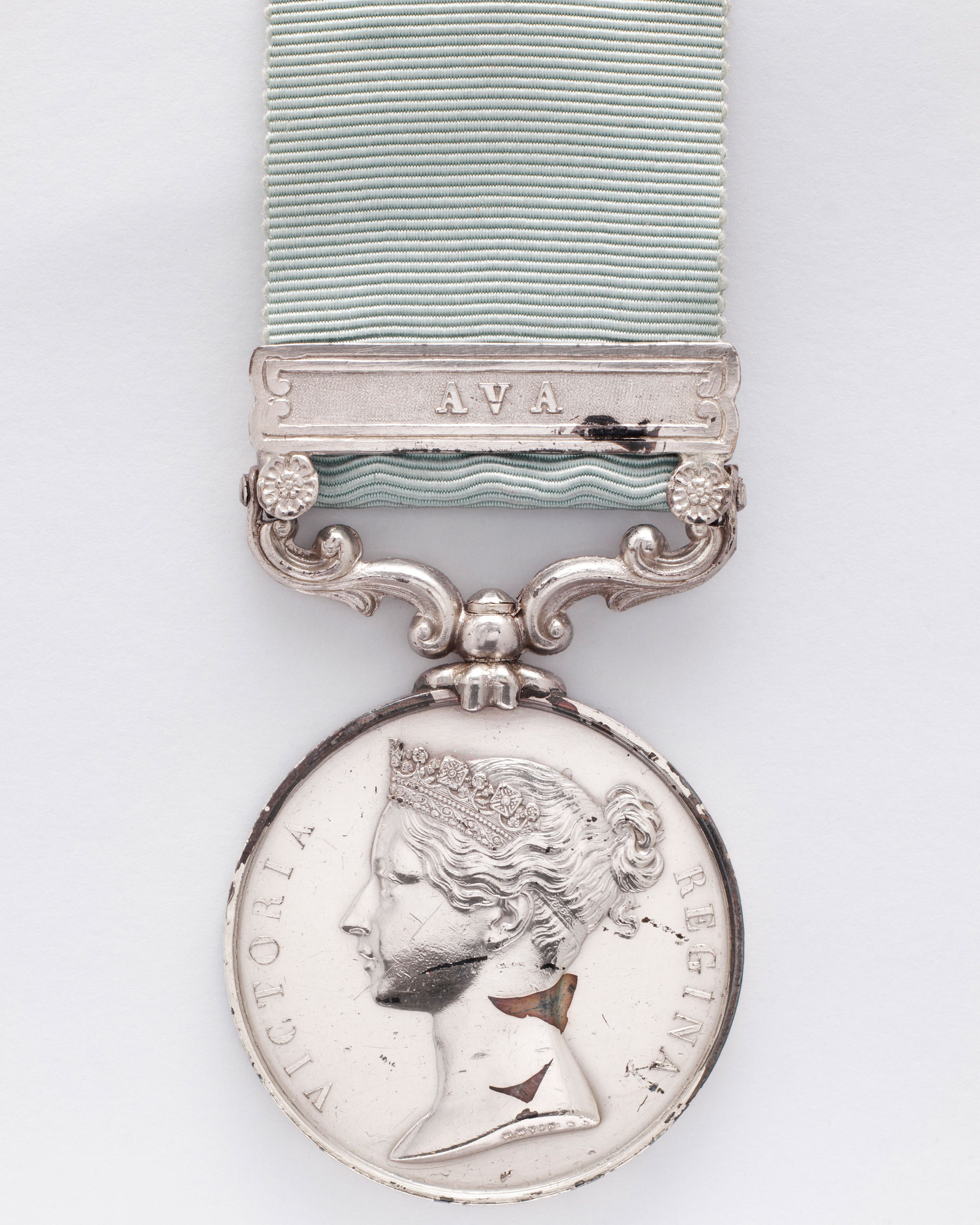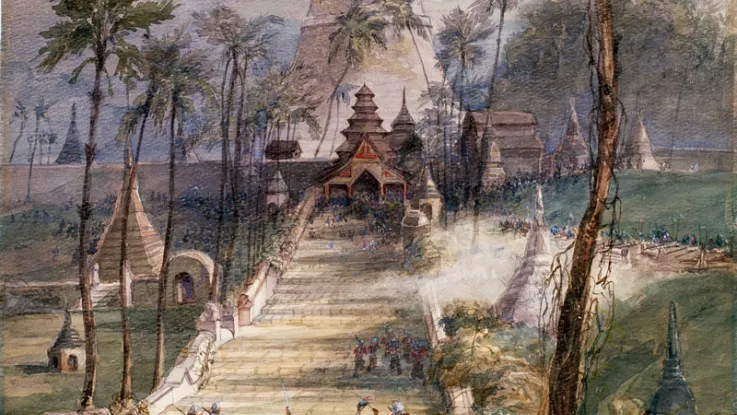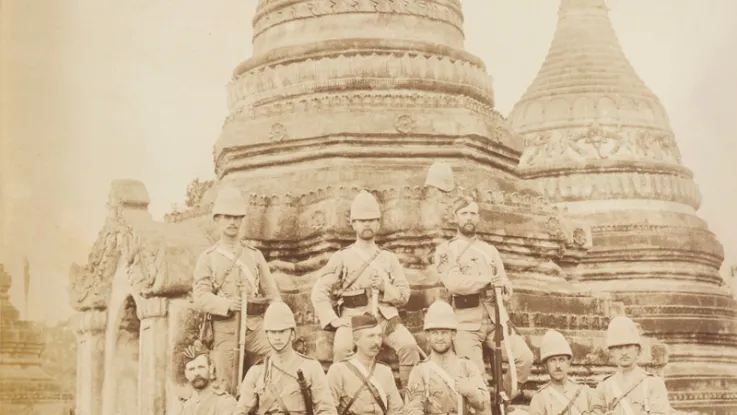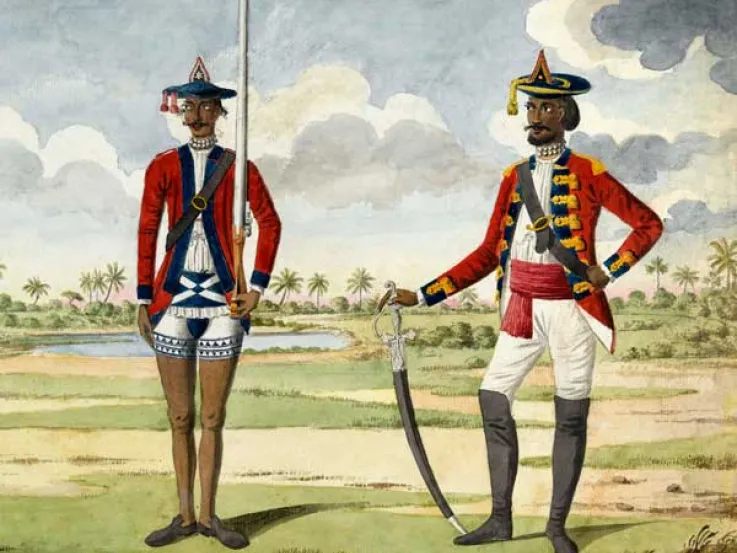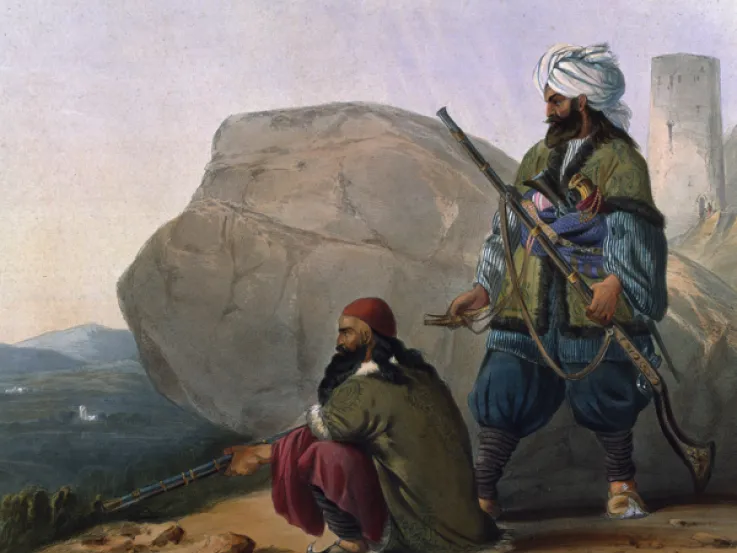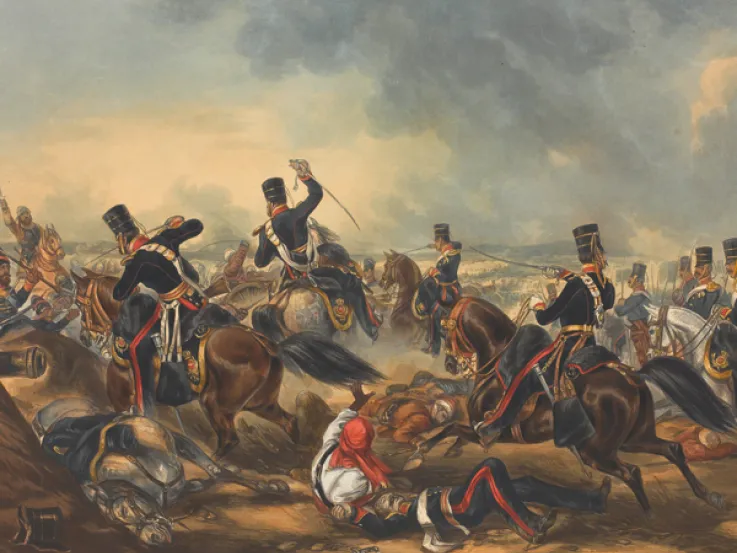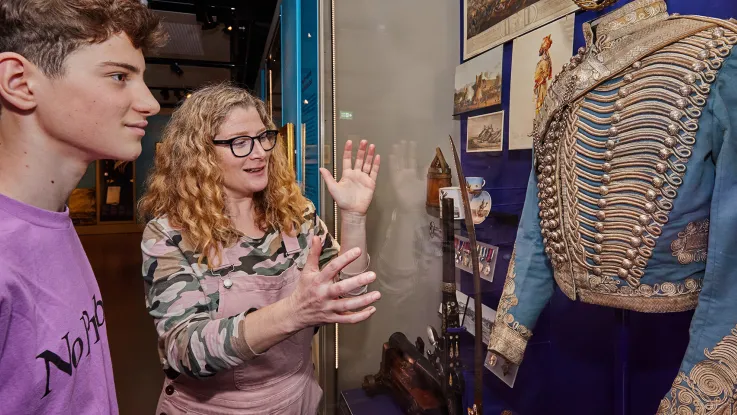Border
During the early 19th century, Burmese military expansion into Assam and Manipur created a long border between the Burmese Empire and neighbouring British India, which was under the control of the East India Company at the time.
The British claimed some of these frontier areas as protectorates, such as Jaintia and Cachar, and allowed anti-Burmese rebels from Assam and Manipur to raid across the border.
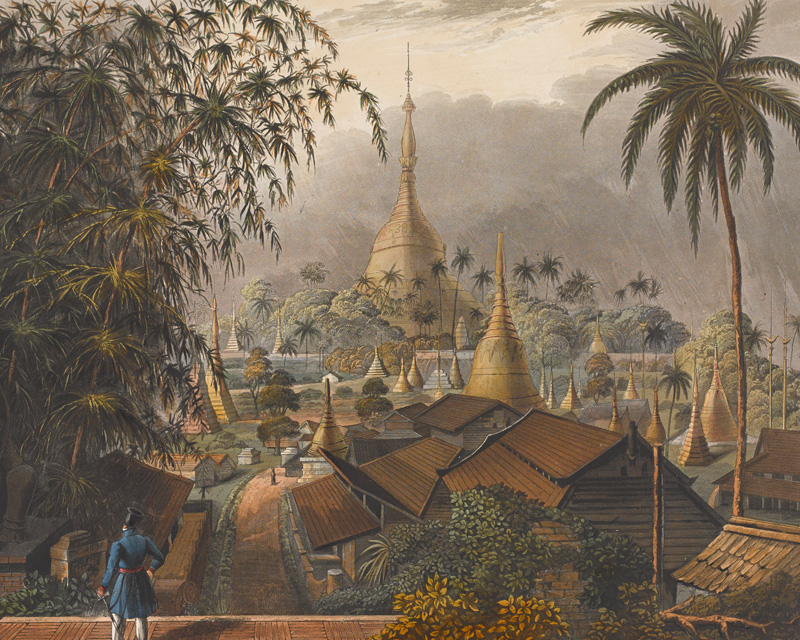
A view of Rangoon in Burma, c1822
Outbreak
In September 1823, the Burmese occupied Shalpuri Island near Chittagong, a territory claimed by the British. After attacking a small British troop detachment, Burmese soldiers entered Cachar.
The British sent troops to eject the Burmese and a small skirmish ensued. The outbreak of further clashes in Arakan (now Rakhine) prompted the British to declare war on 5 March 1824.
The British weren't just looking to secure the north-eastern frontiers of India, they were keen to open up new markets for trade. By establishing themselves in Burma, they also sought to counter French influence, which had been growing there since the mid-18th century.
Burmese forces
Most Burmese soldiers at this time fought with either a musket, spear, bow or dha (sword). They generally preferred to fight on the defensive in bamboo stockades or to engage in jungle skirmishes.
The Burmese also had a variety of artillery pieces at their disposal. But many of their guns were outdated, and their gunnery skills and tactics were relatively poor.
Whenever the Burmese deployed in the open, superior British training and armaments usually prevailed. But when fighting in thick jungle, or in the confines of a stockade, they proved formidable opponents.
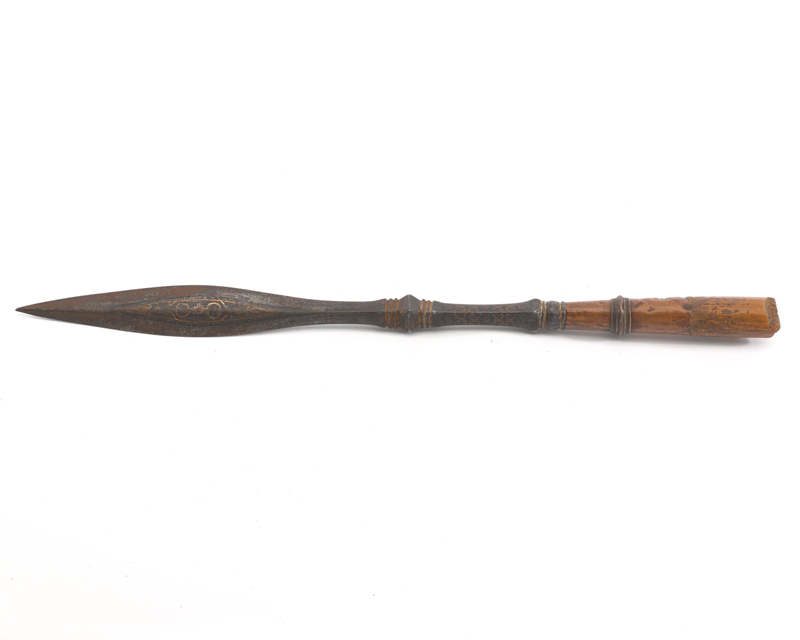
Burmese spear head, c1820s
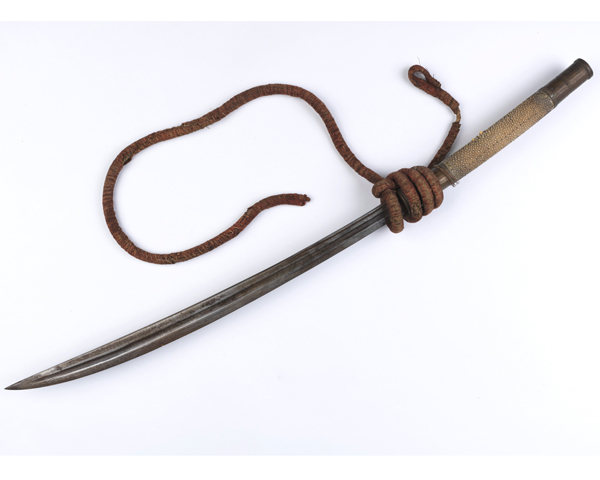
Burmese dha sword, c1820s
Chittagong and Arakan
On 17 May 1824, around 10,000 Burmese troops overran a small Bengal Army force at Ramu near Cox’s Bazar, which they occupied soon after. This Burmese success caused panic in Chittagong and Calcutta, where the British residents formed themselves into emergency militias.
Not wanting to overstretch themselves, the Burmese stopped their advance on Chittagong. Had they taken this lightly defended town, an advance on Calcutta would have been possible. Instead, the British were able to send reinforcements and bolster their position.
In early 1825, 10,000 troops from the Bengal Army, under Brigadier-General Joseph Morrison, were sent by sea into Arakan, supported by gunboats. After establishing a base of operations, Morrison advanced against the outnumbered Burmese, taking the city of Myohaung (now Mrauk-U) in March.
The Burmese position in Arakan had been weakened by the withdrawal of troops to meet a larger British invasion of Rangoon (now Yangon). Their remaining forces evacuated the Arakan soon after.
Rangoon expedition
On 10 May 1824, a seaborne expedition, consisting mainly of Madras Army troops under General Sir Archibald Campbell, landed at the lightly defended city of Rangoon. The British hoped that this would lead to a settlement, but the Burmese fought on. In the weeks that followed, the British systematically captured Rangoon's stockades and fortifications.
After recalling their best troops and their leading general, Maha Bandula, from the Arakan, the Burmese surrounded Campbell’s position in Rangoon with a reinforced army of 60,000 men. Fierce attacks were made against the British defences, but a counterattack by several infantry battalions on 15 December defeated Bandula and scattered his troops.
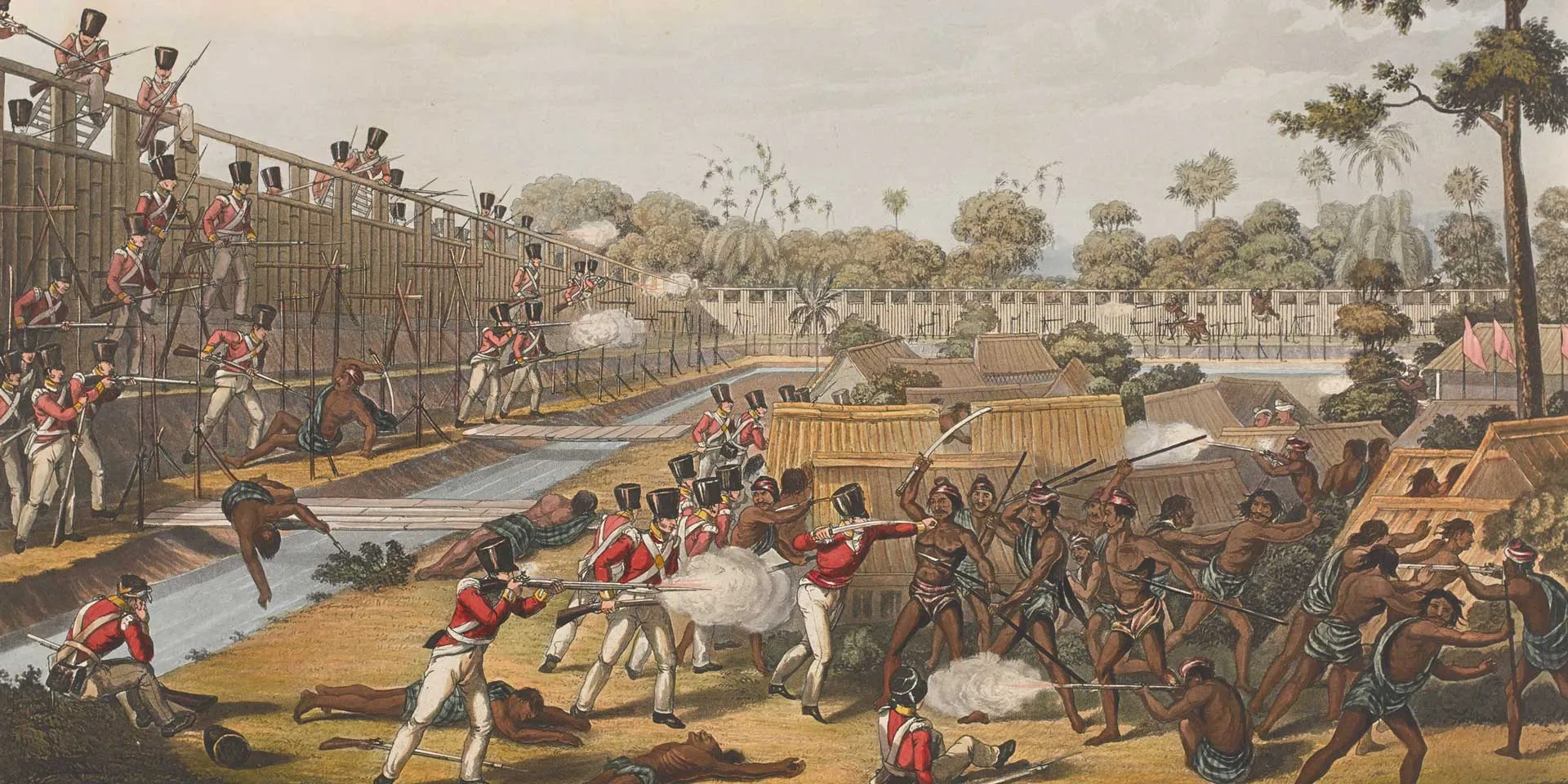
The storming of one of the principal stockades at Rangoon, 18 July 1824
‘Seventeen elephants, each carrying a complement of armed men… were observed moving towards our right flank. I directed the [Governor-General’s] bodyguard to charge them, and they acquitted themselves handsomely, mixing boldly with the elephants; they shot their riders off their backs and drove the whole back into the fort.’General Sir Archibald Campbell at Danubyu — 1825
River advance
Campbell now decided to advance on Prome (now Pyay), which was located hundreds of miles up the River Irrawaddy towards the Burmese capital at Ava (now Inwa).
First, his men attacked the Burmese stockade at Danubyu and, despite an initial repulse, secured it in early April 1825. During the fighting, General Maha Bandula was killed by a British rocket as he walked around the defences to boost his men’s morale.
On 25 April, the British occupied Prome. Campbell remained there for the monsoon season, but faced a counterattack in late November from a large Burmese force. After beating this off, he pursued the Burmese further up the Irrawaddy, winning several more victories, including at Malun on 19 January 1826 and Pagan (now Bagan) on 9 February.
With Campbell's men now approaching the imperial seat of power at Ava, the Burmese sued for peace.
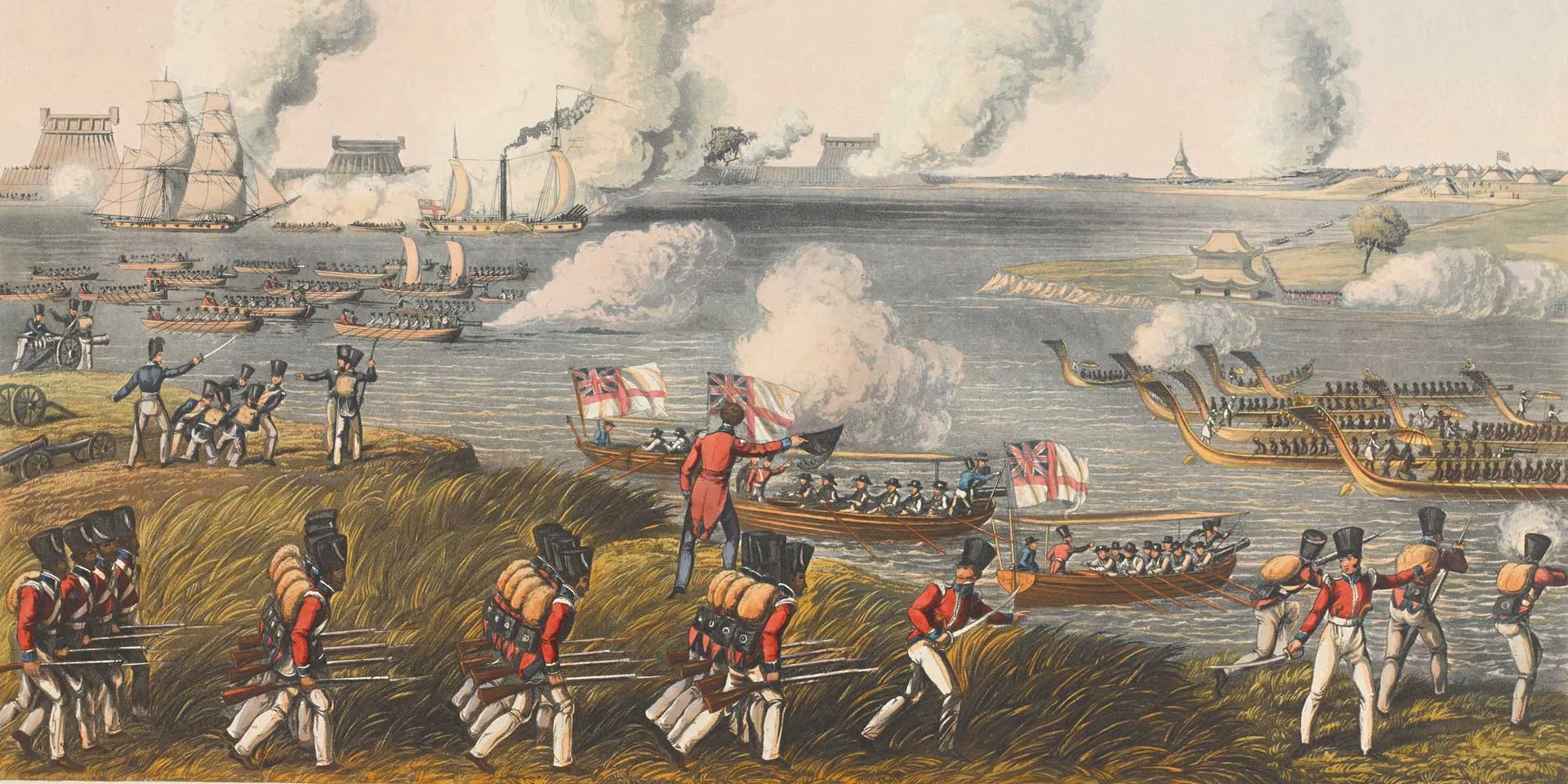
Assault on the Burmese positions at Danubyu on the River Irrawaddy, 27 March 1825
Peace
The war ended in February 1826 with the Treaty of Yandabo. This led to the British annexation of Arakan, Assam, Manipur and Tenasserim (now Tanintharyi). The Burmese also had to renounce their claims to several disputed frontier areas, including Cachar and Jaintia.
On top of this, the Burmese had to pay a large indemnity, sign a commercial treaty and accept a British Resident at the imperial court at Ava.
The East India Company awarded the Burma Medal to Indian soldiers who served in the war. The Europeans - including Company officers and members of the British Army - were not eligible for this. But surviving European soldiers later qualified for the Army of India Medal with the clasp 'Ava', established in 1851.
On campaign
For many soldiers in Burma, the most dangerous enemy was the rough terrain, thick jungle and punishing climate. The monsoon made rivers impassable and it became difficult to move supplies and artillery.
At least 15,000 British and Indian soldiers died, together with an unknown number of Indian and Burmese labourers and camp followers. Three-quarters of the British-Indian losses were due to diseases like malaria, dysentery and dengue fever, as well as the effects of heat stroke.
It was not just the rank and file who succumbed to the conditions. Brigadier-General Morrison died on his way home to Britain, the victim of a ‘malignant jungle fever’ contracted in Arakan.
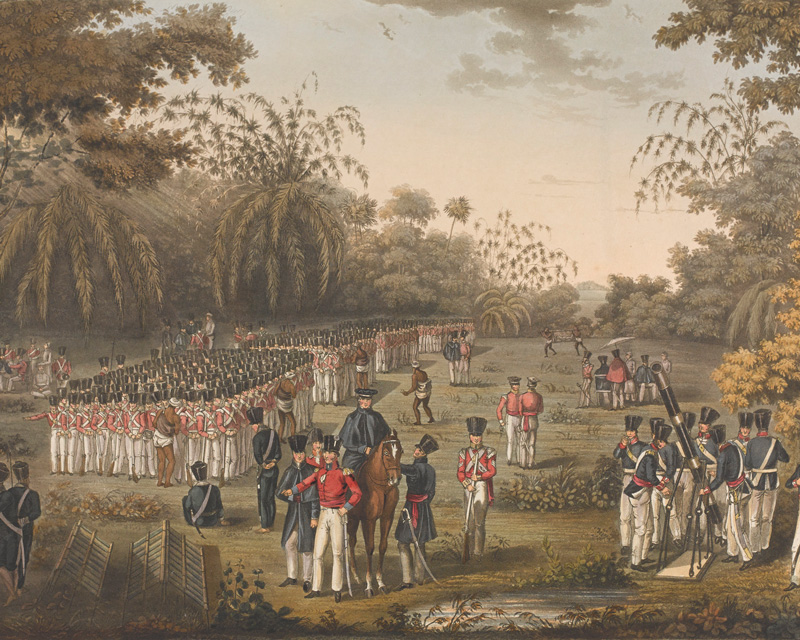
Troops in the Burmese jungle, 1824
Aftermath
The conflict’s huge financial cost contributed to an economic crisis in India. In turn, this brought about the decline of the East India Company and led to greater British government intervention in Company affairs during the 1830s.
The war also weakened the once-powerful Burmese Empire. As well as losing important territories, the high cost of the indemnity (over £1 million) hobbled the Burmese economy.
The country would come under British occupation again during the Second Burma War (1852-53). This conflict was largely provoked by the Company, which coveted more territory and Burmese resources like teak and rubber.
